Elephants: India
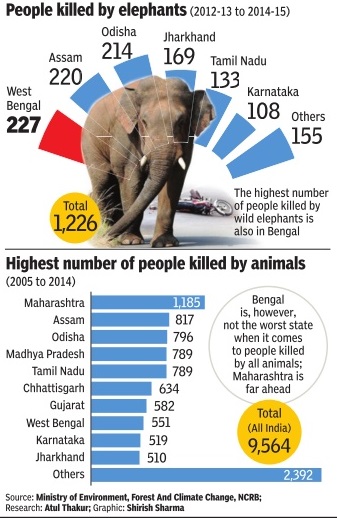
This is a collection of articles archived for the excellence of their content. |
Contents |
2012-16: Attacks on humans
Please see graphic and Tigers: India
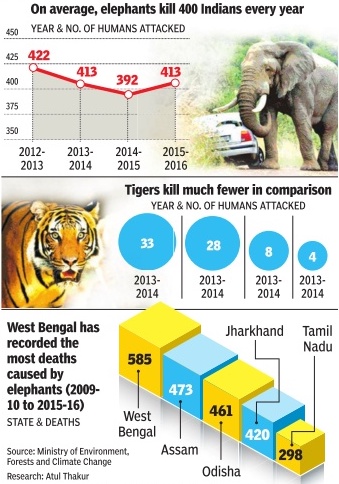
2013-15: Slaughter in the south
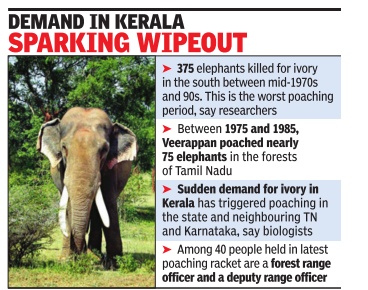
The Times of India, Aug 13 2015
100 elephants killed in 2 years across south
Viju B & Oppili
Worst jumbo carnage since Veerappan run
Kunjumon has lived most of his adult life in the forests of Kerala -as a government watchman and then as a cook for poachers.That transition made little difference, he told cops. It was the killing of a baby elephant in 2014 that changed his life.In June 2015, the 62-yearold walked into a forest office and made his peace.
What emerged in the probe was a massive poaching operation for tusks (ivory) in not just Kerala, but neighbouring Tamil Nadu and Karnataka as well. Investigators in Kerala found that the gang had killed more than 20 elephants in 10 months, but forest officials told that the toll in the southern region in the past two years could be as high as 100. And this would be the gravest of periods for elephants in the south after forest brigand Veerappan was gunned down in 2004.
Investigations in the past two months point to a nexus of poachers and forest officers.Among the 40 people arrested so far is a forest range officer and a deputy range officer.They also found poachers' dens in the Vazhachal forest and at least 17 crude guns.“The officials would open the check posts for the poachers to cart away the ivory once the elephants were killed,“ said a senior vigilance official with the forest department.
In Tamil Nadu, officials found rampant poaching in Sathyamangalam and Mudumalai tiger reserves, and Bandipur in Karnataka. The mastermind, Aikaramatton Vasu, was found dead in a farmhouse in Dodamarg in Maharashtra. There was a suicide note as well.
Population, state-wise
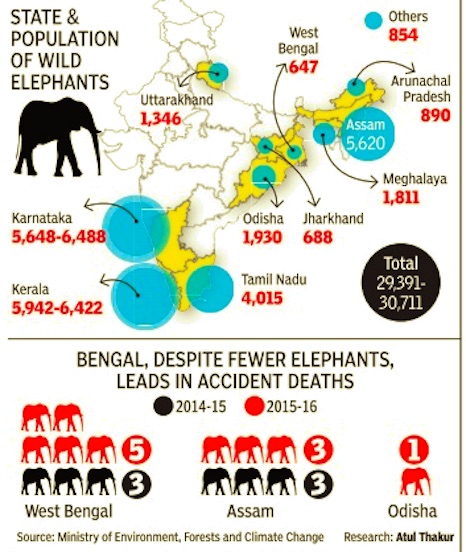
Uttarakhand
Corbett and 11 other divisions
The Times of India, Aug 23 2015
Seema Sharma
1,035 elephants rule tiger bastion Corbett
For those who equated Corbett with just tigers, think again. As per the recent elephant estimation exercise conducted in Uttarakhand in June, Corbett Tiger Reserve (CTR) has emerged as one of the main bastions of elephants with the presence of as many as 1,035 pachyderms being recorded in the reserve. According to the estimation exercise, the state has a total of 1,797 elephants which is an increase of 15% over the last estimate carried out in 2012, when 1,559 elephants were recorded. It is also a rise of almost 33% over the last census of 2007 when 1,346 elephants were counted.
Elaborating on the methodology used for the estimation exercise, Dinesh Aggarwal, state forest minister, told TOI, “The estimation was conducted in CTR, Rajaji Tiger Reserve and 11 territorial divisions of Shivalik, Eastern & Northern Kumaon and Bhagirathi circles covering an area of 6643.5 sq km. Methodology was based on direct synchronized counts and detailed information about each elephant sighting. about each elephant sighting.GPS coordinates were recorded and reviewed and collated at the Wildlife Institute of India.“
The steady increase in jumbo numbers comes after a 50% increase registered in tiger sightings in Corbett. Dhananjay Mohan, who headed the exercise, told TOI, “Our effort to improve the habitat conditions in Corbett has paid off. Special efforts were made to remove weeds and lantana, which helped in expanding the feeding ground for elephants.“ Another reason, according to Anil Dutt, principal chief conservator of forests (wildlife), is that Corbett has the Ramganga river, a perennial source of water, because of which the ranges situated close to it, like Dhikala and Sarpduli accounted for 242 and 193 jumbos respectively .
Assam
Kaziranga National Park
The Times of India, Aug 17, 2016
Rohit Khanna & Prabin Kalita
'Bangabahadur' of Assam dies in Bangladesh
A wild elephant, which had got separated from its herd in Kaziranga National Park in June and which was swept away by the Brahmaputra to Bangladesh, died despite all efforts to save her. The adult female elephant, named Bangabahadur (hero of Bengal) by locals in Bangladesh, was first spotted in Kurigram district in that country. It travelled further downstream through Bogra and Sirajganj districts before finally washing up in Jamalpur district in the third week of July. On August 3, a three-member team from Assam travelled to the neighbouring country to bring back the animal but the plan was abandoned and it was decided that the jumbo would be relocated to a safari park in Bangladesh. On August 11, the elephant was rescued from a pond in Kayra village in Sharishabari being being tranquillized thrice. Bangladesh media quoted officials as saying the elephant was 'too weak and tired'.
The animal died at around 6:30 am in Kayra, Bangladesh media reported. "Bangabahadur was becoming restless so we had to give him tranquiliser. It was a very measured dosage, but we could not determine that his health conditions had deteriorated so much," said Tapan Dey, deputy chief conservator of forests of Bangladesh forest department. According to him, Bangabahadur was gradually becoming weaker as he was out of his usual habitat.
"It seems that he had swept through the river for around 1,000 kms. This has not only weakened the elephant, but taken a toll on his overall health. We suspect that the elephant was also suffering from pneumonia," said Dey. He added that Bangabahadur was kept chained but started becoming restless since Sunday afternoon. "He refused to eat and tried to break the chains on Sunday. We decided to keep him under sedation and he was injected with tranquiliser," Dey said. Accordingly, measured dosages of tranquiliser was injected. But scorching heat, coupled with weakness, was deteriorating his condition faster. According to Hasibur Reza Kallol, treasurer of Bangladesh-based NGO People for Animal Welfare, the situation could have been avoided if there was no pressure to send it back to India. "It was entirely a new habitat for the elephant and it needed time to acclimatize. More time to get him habituated with the new ambience could have saved his life," he said.
Karnataka
Manchanabele Reservoir
The Hindu, November 6, 2016
MOHIT M. RAO
Jumbo question: Life or death for ailing Sidda?
Although euthanasia is legal for animals, public pressure has made the decision nearly impossible. The narrow, uneven and dusty road that skirts the sprawling Manchanabele Reservoir in Karnataka has seen unusually busy traffic. The attraction is Sidda, a 35-year-old elephant, which has, since its injury, been confined to the banks of the reservoir for 57 days.
Just one leg seems to have the energy to undertake a futile attempt at scooping muck across its immense, heaving torso; while its trunk lugubriously rolls around towards puddles of water. The foreleg is visibly swollen as its wound festers. Behind it, the Forest Department has set up a camp with at least eight personnel, including veterinarians. In shifts, they spray water on Sidda to keep it cool on warm days.
On August 30, 2016, while being chased by villagers on the outskirts of Bengaluru, Sidda fell into a ditch. It was given treatment and escorted back to the Savandurga Reserve Forest. However, crippled with severe pain, on September 11, the elephant was spotted again floating in the backwaters of the reservoir. Its condition deteriorated and, for the past fortnight, it has been recumbent and immobile. The list of ailments is long: compound fracture, septicemia, partial blindness, dehydration, swelling of the leg and anaemia.
‘Let nature decide’
Officials say public pressure has made the decision nearly impossible and they would now “let nature decide.”
One self-proclaimed animal rights activist from the United States has threatened to cancel her donation to an NGO if it does not euthanise. “You chose to take credit for “helping” Sidda and to bask in the glory... and now there is no glory for Sidda and there is no comfort for him as he lies dying a horrible, painful death,” she says in her online post.
However, Arun A. Sha, veterinary officer of the NGO Wildlife SOS treating Sidda, says it is premature to think of euthanasia. “It is still showing traits of a wild elephant and moving its trunk and hind leg. It is in pain, but we are providing pain killers…We have just received permission to make an apparatus that can help to shift the weight from the fore leg. If we prop up Sidda, he can perhaps recover better,” he says.
“We will continue to treat the elephant the best that we can…If only experts decide on euthanasia, we can form a committee to look into it,” says Dileep Kumar Das, Chief Conservator of Forests (Project Elephant).
The idea, however, is subsumed by community passions. “It churns our stomach to see the suffering. But euthanasia is not an option. When people are sick in the hospital, the family is ready to spend lakhs on treatment. The same should be for our Sidda,” says Shivamma, from the nearby village of Dubbaguli.
Sympathy amid conflict
The irony of the love for Sidda seems to be lost in the State which sees an unending, escalating conflict between humans and elephants. In the past three years, around 105 people have been killed; while, yearly, more than 10 elephants are electrocuted or shot.
Asian Elephant Researcher Surendra Varma believes the “signals” sent out by Sidda and Ranga need to be understood if the State wants better conservation.
“There has to be understanding of the root causes of these elephants coming out of protected areas. Mitigation measures have not been up to the mark, while cropping patterns which attract elephants have not been addressed,” he says.
Odisha
Marginal increase: 2015-June 2017
Satyasundar Barik, Elephant population sees marginal rise in Odisha, July 4, 2017: The Hindu
Jumbo numbers have gone up by 22 since 2015
The first ever synchronised elephant census carried out in the country’s eastern region, involving four States, has found 1,976 elephants living in different forests of Odisha.
The synchronised elephant census-2017, the results revealed that the jumbo population has gone up marginally by 22 elephants compared with 1,954 in 2015.
Direct sighting
The elephant census was carried out simultaneously in Odisha, West Bengal, Jharkhand and Chhattisgarh between May 9 and 12. Apart from direct sighting, indirect estimation of elephant through dung decay rate method by using line transect technique was also deployed. The Indian Institute of Science in Bengaluru carried out the census.
While the number of male elephants, which are vital for a healthy population, stood at 344, there were 1,092 females in Odisha forests. The young elephant population was estimated at 502, but the gender of 38 elephants could not be ascertained. In 2015, there were 341 male elephants.
Of 43 forest divisions where the census was carried out, elephants were found in 37 divisions. No elephant was found in Khariar, Chilika Wildlife, City Division, Koraput, Jharsuguda and Bargarh.
Odisha has three elephant reserves comprising seven sanctuaries. These were found to have 1,536 elephants or 77.73%. While 79 elephants were roaming in five other sanctuaries, 361 were sighted outside elephant reserves and sanctuaries. The highest number of 330 elephants was sighted in the core of Similipal followed by Dhenkanal with 169. Chandaka Wildlife Sanctuary, which once boasted over 80 elephants, has only one elephant. As many as 5,847 people were engaged for enumerating the jumbos in different forests.
Odisha has recorded one of the worst man-elephant conflicts in the country. Since 2013-14, 311 elephants have been killed with annual average elephant deaths estimated at over 70. During the same period, 275 humans lost their lives in elephant depredation.
2017: population stable
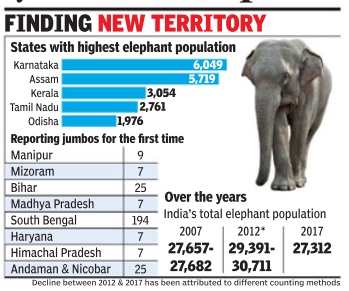
See graphic: States with highest elephant population, 2017
India's elephant habitat has expanded, with the jumbo population “stable“ at 27,000, according to a census of the animals released by the Union ministry of environment, forests and climate change, World Elephant Day .
The report, `Synchronised elephant population estimation India 2017', pegs the exact population of jumbos at 27,312, with Karnataka accounting for the biggest share followed by Assam.
The figures show a decline in the overall population, from 29,391-30,711 in 2012, but this has been attributed to a difference in the counting methods used.
“There is no question of a decline,“ said elephant expert and head of Asian Nature Conservation Foundation R Sukumar. Experts termed the “expansion“ trend worrying because it could lead to an increase in human-animal conflicts.